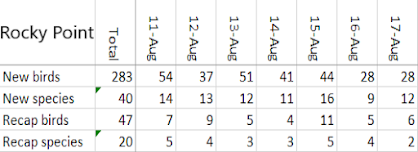This fourth week of Migration banding continues to offer volunteers, banders and visitors alike some new opportunities to hone their skills of observation, and share in the overall exchange of learning that seems inherent to the ventures of a banding station. The past 7 days have brought ample highlights and a few insights into how the migration season is progressing, with the arrival of some new first of the year (FOY) species! As well, we have an update to follow regarding the Olive-sided flycatcher family that have made their home behind the banding station at Rocky.
This week Rocky Point station banded a total of 283 new birds, and Pedder Bay 185, for season- to- date totals of 1,004 and 855, respectively. Amazingly, Rocky Point hit a season milestone of 1,000 new birds banded this season on Wednesday, August 17th . Not to anyone's sursprise, the 1,000th bird was a White-crowned Sparrow ("Puget Sound"- we are still yet to have a “Gambel’s” for either station this year), one of 105 to date for Rocky.
The top species by number of new bands remains Wilson’s Warblers- a station favourite for whom the interns and volunteers are becoming
quite acquainted! Rocky added 51 “WIWA” bands to the season total of 242, while
Pedder added 26 for a total of 135 to date for these small, hat wearing
warblers.
 |
| A male Wilson’s Warbler, from earlier this season. (Aiva Noringseth) |
Keeping with the theme of yellow hues, our first feature is another warbler; First of the Year Grey-headed “orestera” or “Interior Montane” subspecies of Orange-crowned Warblers have arrived for both Pedder and Rocky. With consideration of other early arrivals this week, including FOY Savannah Sparrows and a Lincoln’s Sparrow making appearances in our banding totals, fall migration is swiftly getting underway, signalled by the return of these more afar- breeding species.
 |
| Grey-headed Orange-crowned warbler. (David Bell) |
What is white and blue and loves Nets labelled “2”? This HY
Belted Kingfisher, evidently! Originally
extracted from Rocky Point’s Net 2 and banded by intern Evan Lewis on Aug. 8th,
this young female was recaptured in Pedder Bay’s Net 2 on Aug. 11th
- 3 days later. The action and attitude offered from these birds conducts
anyones attention quite easily, and the seldom up- close encounters make for
excellent practice for trainees, as kingfishers unique body plan requires
different techniques than our typical passerines.
 |
| A returning client, Belted Kingfisher recap from Pedder Bay. (Aiva Noringseth) |
Western Wood-Pewees have been heard calling at both stations
on census and general observations, but this individual proved to be our first
of the season to be banded! A welcome visitor, we hope to see more of these
small flycatchers in the coming weeks.
 |
| Western Wood-Pewee from this week at Rocky. (David Bell) |
 |
| A cryptic Alder Flycatcher marked a 4th ever record for RPBO. (David Bell) |
With noticeably larger flocks looming about at Rocky Point, perhaps it was only a matter of time untill this highlight bird would come to join us at the station. This hatch year European
Starling was banded Thursday morning (Aug. 11) at Rocky. Though their plumage
may include a range of stunning features, that pink moustachial stripe is simply
a dye- job produced by this individual’s passion for blackberries, something we
can all appreciate at this time of year.
 |
| First European Starling of the season. (Samuelle Simard-Provençal) |
As hinted in the title of this blog, our resident Olive-sided Flycatcher family at Rocky Point continue to stoke wonder for observers, giving newfound appreciation for early life history events and behaviours of passerines that are seldom seen so regularly. With 19 days between them and their hatch date, on Aug. 17th at least 2 of the 3 young have now taken the ultimate pledge- they’ve fledged! Hopes are high that we may encounter the young ones during Migration banding.
 |
| Three Olive-sided flycatcher chicks in the nest solicit food from an incoming parent. (David Bell) |
The frenzy of forage fish schools and returning salmon running just offshore between Pedder Bay and Beechey Head draws the attention of both fishermen and seabirds alike, and has made for some continued observation highlights this week. A first of the season Sooty Shearwater was spotted off the shores of Rocky Point just days before the first Parasitic Jaeger was seen in a likewise manner. Delighting our scope views, the busy flight of alcids out on the water has included dozens of Rhinocerous Auklets, Common Murres and Pigeon Guillemots, all taking advantage of the seasonal influx of forage fish. Other non- avian sights and sounds have included frequent deer, squirrel chatter, harbour porpoises bobbing off shore, the groans of Stellar’s and California sealions echoing across the water from Race Rocks, a cacophony of California gulls, and even a chance visit from Rocky’s resident sea otter, “Ollie”.
 |
| A rainbow flaring in the first light of dawn, looking west at Rocky Point. (Aiva Noringseth) |
The excitement is building at both stations, as the variety
of species banded and recaptured rises incrementally each day. Though the intensity of numbers are expected to begin to increase in the coming weeks, it is the efforts of our volunteers and staff keeping both banding stations are running at an optimal pace and adapting with each change the season brings our way.




No comments:
Post a Comment